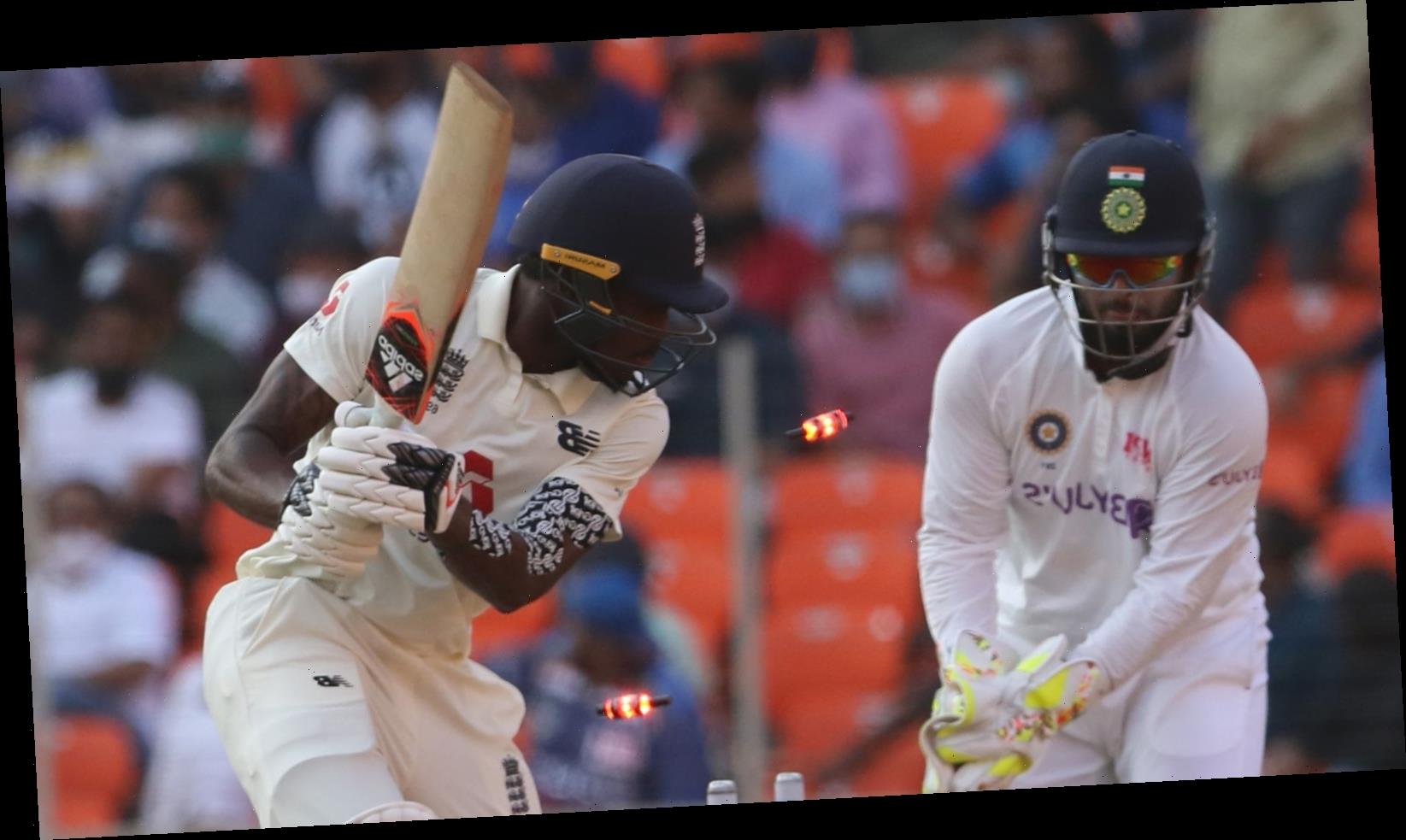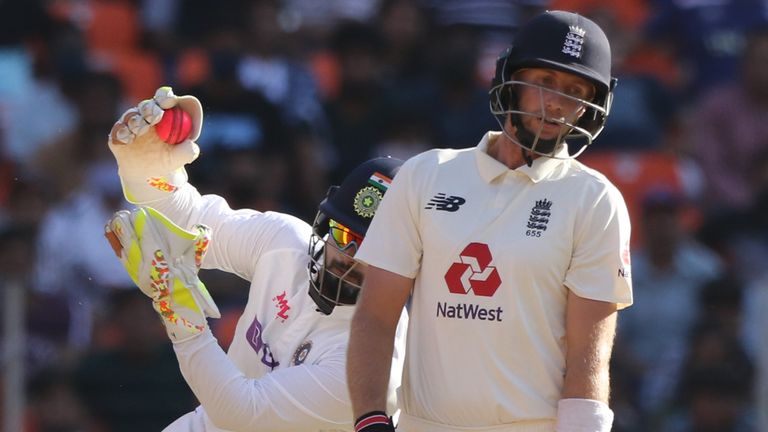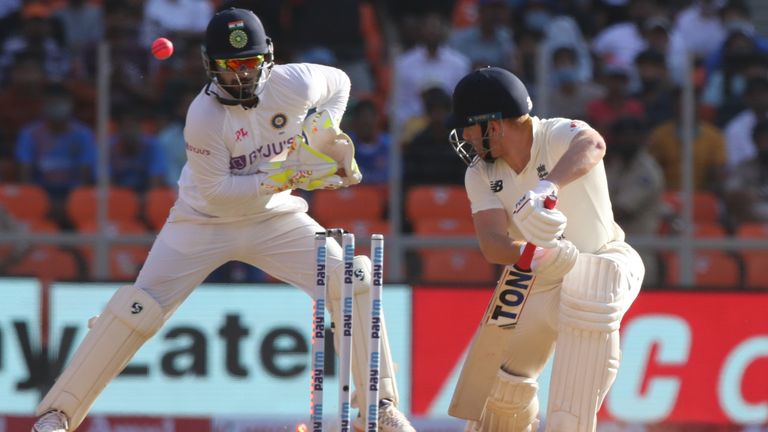With just 842 balls bowled, England’s defeat to India in Ahmedabad was the shortest completed Test match since 1935.
While Virat Kohli and his team celebrated going 2-1 up with one game left in the series, and for all the excitement of seeing 30 wickets fall in just over a day and a half, there was a sense of disappointment among many cricket fans that the much-anticipated day-night Test was over after little more than five sessions.
https://youtube.com/watch?v=P2y3zDvB-Bk%3Ffeature%3Doembed
The reason for such a short, sharp game in a format usually associated with a more slow-burning type of excitement and anticipation of, in the best instances, a thrilling finale, were being debated on social media well in advance of Rohit Sharma hitting the winnings runs.
- England crumble to 10-wicket defeat inside two days
- Rob Key: Pitch was not fit for Test cricket
- Joe Root: We can’t have batting scars for final Test
For most it seemed to boil down to one of two things – anyone who has watched England play in the subcontinent before will be all too aware of what they are – either it was down to the tourists’ inability to play quality spin bowling or it was the result of a substandard pitch.
Both the quality of batting, on both sides on this occasion, and the surface clearly played a part but was there more to it than that? Here are a number of factors than led to this historically short Test match…
THE PITCH
It is the obvious place to start. The bowling can be good, the batting can be bad but after any Test match that lasts less than two days, there has to be questions over the pitch.
England’s players have remained diplomatic on the subject, “challenging” or “tough to bat on” the phrases they have used when asked about a surface that took spin from very early on the first morning.
Unlike the pitch in the second Test in Chennai that saw balls bursting through the surface with great regularity and turning big time and again, in Ahmedabad, it was arguably even tougher for the batsmen as the turn was more sporadic.
At times it seemed like batsmen were relying on potluck to survive as two seemingly identical balls would do very different things, one gripping and spinning sharply out of the surface and then next skidding on quickly.
“It was pretty much a lottery if you were a batsman,” said Sky Sports pundit and former England batsman Rob Key.
“It was compelling viewing, no doubt about that – as it always is when you play on a pitch that is not fit for Test cricket.
“People can say we are moaning because we’re England fans and we want them to do well but this doesn’t stack up against what you are meant to do to prepare a surface for Test cricket.”
The best pitches are supposed to provide a fair contest between bat and ball. Given only two batsmen – one on each side – across four innings registered a score in excess of 30, you would be hard pushed to find anyone watching who viewed it that way.
I suppose there was Virat Kohli; although intentional or not, his assessment sounded more like a dig at England’s efforts on day one.
“It was a very good pitch to bat on,” he said, “especially in the first innings.”
Hmm.
THE BATTING
In fairness to the India captain, his remark was part of an answer in which he was discussing the batting on show over the two days.
“The result went our way but I don’t think the quality of batting was at all up to standard from both teams,” he said. “There was a lack of application from both sides.”
There was undoubtedly an element of that and, as Kohli says, it was on both sides. England will take the brunt of the criticism on this front because they lost the game and you can pretty much pinpoint the moment it got away from them.
It came shortly before lunch on day one when Joe Root was done in the flight by Ravichandran Ashwin and trapped lbw, that wicket ended a partnership of 47 between the England captain and Zak Crawley and England, having recovered from the loss of two early wickets to reach 74-2, promptly collapsed to 112 all out.
As we have already mentioned, the pitch was making life difficult even when it was supposedly at its best – but 112 all out? That total came to look slightly better given the way the rest of the match panned out, but it was still under-par, even a score of 180 might have made all the difference.
There were not many shots you could point to and say they were reckless but equally, even after the heavy defeat in spinning conditions in Chennai, there was element that there was no real plan to try and deal with such conditions.
In their defence, India hardly fared much better. From 98-2 late on the first evening, they crumbled to 145 all out. This from players who have grown up playing on turning tracks and yet they seemingly had no answer for Jack Leach or even the part-time spin of Root.
From 0-2 after three balls, England’s 81 all out second time round almost felt like a decent recovery and again there were lapses, both technical and mental, that will have frustrated them. That said, by day two batting had clearly become fiendishly difficult.
“Trying to play properly today? It was nigh-on impossible,” Sir Alastair Cook said on Channel 4. Given he averaged over 50 in Asia, that suggests the batsmen deserve plenty of slack, at least in the second innings.
THE BOWLING
Often when these low-scoring games occur, there is such a rush to lament the batting or the pitch that the quality of the bowling can be overlooked.
Even in a game in which Axar Patel, playing in just his second Test, took 11 wickets and Ravichandran Ashwin claimed his 400th Test wicket, those achievements have not received top billing.
The same can be said of Leach, who dismissed four of India’s top five, all of whom can be considered very good players of spin. In fact, it is arguably Root’s 5-8 that garnered the greatest reaction and even that was as much due to him being a part-timer with the ball as it was to with those remarkable figures.
Of course, all the spinners had a lot of things in their favour but they still needed the accuracy, consistency and skill to make full use of it.
“I think it sums the wicket up if I am getting five wickets! It was nice to contribute but disappointing it was in a losing cause.”
Joe Root on his career-best 5-8 (Pic credit – BCCI)
Axar was the pick of the bunch, the left-arm spinner threatened both edges and his line was immaculate throughout. When batting is as tricky as it was in Ahmedabad, batsmen are just waiting for a loose delivery, something to help ease the pressure. Axar, in particular, gave them nothing and Ashwin and Leach were almost as efficient.
THE BALL
Interestingly, though, when Root was asked about why batting had proven so difficult, his first thoughts were not of the pitch or the skill of the bowlers – although he was quick to add that that played a part.
“The ball, if I’m being honest,” he said. “That plastic coating gathers pace off the wicket. It is good quality bowling.”
There was a lot of talk about the pink ball pre-match, plenty of it was in reference to how it might help the pace bowlers, how much it might swing and so forth.
The extra lacquer on the ball was noted by the players and it was mentioned that where the spinners were concerned, that might make the ball skid on more rather than turn sharply. It was commented on briefly, not to say that it would make the spinners any more or less effective, just to say it might happen.
As it was, those balls that slid on proved the most telling throughout the match, the extra hardness from those additional layers of lacquer meant that the ball wasn’t just going on with the arm, they were doing so quickly and, according to Root, seemed to increase in speed off the surface.
Trying to deal with that would have been hard enough, but when the very same delivery might land on the seam, grip and turn, it is easy to see why so many top-class batsmen were suddenly looking distinctly ordinary.
“If you put the ball in good areas consistently and some spin and some go straight, it makes it difficult for batters,” Root said. “You could say both sides struggled with that, not just us.”
For the England batsmen, having contributed to an effort that saw their side fail to reach 200 over two innings, that is something for them to cling to going into the final Test: India’s batsmen struggled too.
Had they not, the match may well be heading into a third day. As for why it isn’t, you can take your pick as to what was the biggest contributing factor, it took a combination of the lot to leave cricket fans wondering how to fill their time over the next three days.
Source: Read Full Article














